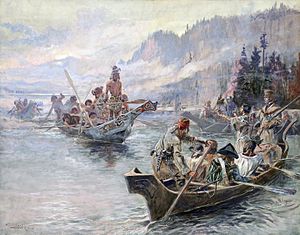Loading AI tools
Unit of the United States Army From Wikipedia, the free encyclopedia
The Corps of Discovery was a specially established unit of the United States Army which formed the nucleus of the Lewis and Clark Expedition that took place between May 1804 and September 1806. The Corps was led jointly by Captain Meriwether Lewis and Second Lieutenant William Clark. Commissioned by President Thomas Jefferson, the Corps' objectives were scientific and commercial – to study the area's plants, animal life, and geography, and to learn how the Louisiana Purchase could be exploited economically.[1] Aside from its military composition, the Corps' additional personnel included scouts, boatmen, and civilians.
| Corps of Discovery | |
|---|---|
 The Corps of Discovery meet Chinooks on the Lower Columbia, October 1805 (Charles Marion Russell, c. 1905.). | |
| Active | 1803–1806 |
| Disbanded | September 1806 |
| Country | United States |
| Branch | Army |
| Role | Exploration |
| Size |
|
| Commanders | |
| Captain | Meriwether Lewis |
| Second Lieutenant | William Clark |
On its two-year expedition through the Great Plains and the Rocky Mountains, the Corps encountered more than two dozen Native American tribes. Modern research now acknowledges that without such contact or help, the Corps of Discovery would have struggled to have completed their journey.
The foundations for the Corps of Discovery were laid when Thomas Jefferson met John Ledyard to discuss a proposed expedition to the Pacific Northwest in the 1780s.[2][3] In 1802, Jefferson read Alexander Mackenzie's 1801 book about his 1792–1793 overland expedition across Canada to the Pacific Ocean; these exploratory journals influenced his decision to create an American body capable of reaching the Pacific as well.[4][5][6] Two years after taking the presidency, Jefferson asked Congress to fund an expedition through the Louisiana Purchase.

In 1803, President Thomas Jefferson commissioned the Corps of Discovery, and named as its leader his personal secretary and U.S. Army Captain, Meriwether Lewis, who selected William Clark as his partner.[7] The goals of the Corps of Discovery, whose cadre would be raised primarily from the U.S. military, was to explore the Louisiana Purchase, and establish trade and U.S. sovereignty over the native peoples along the Missouri River. Jefferson also wanted to establish a U.S. claim to the Pacific Northwest and Oregon territory by documenting an American presence there before other European nations could lay title to the land.[8][9][10]
The U.S. mint prepared special silver medals with a portrait of Jefferson and had a message of friendship and peace, called Indian Peace Medals or peace medals. The soldiers were to distribute them to the nations they met. But the Corps would be prepared for any acts of hostility because it would be equipped with the most advanced weapons available, such as rifles and a .46 caliber Girandoni Air Rifle.[11][12][13][14] The Corps of Discovery was equipped with sufficient black powder and lead for their flintlock firearms, knives, blacksmithing supplies, and cartography equipment. They also carried flags, gift bundles, medicine and other items they would need for their journey. Much time went into ensuring a sufficient supply of these items.[11][12][13][14]

To create the Corps of Discovery, and to ensure any chance of success, Lewis wanted to find the best possible men he could and recruit them to join his expedition. Men were expected to be excellent hunters and possess skills that would ensure their survival in the wilderness. He also wanted men who were brave, unmarried, and healthy. Lewis entrusted recruitment to Clark. He went to Louisville, Kentucky, where he found his first recruits, then Clarksville, Indiana. This group eventually became known as the "Nine Young Men from Kentucky": William Bratton, John Colter, Joseph Field, Reubin Field, Charles Floyd, George Gibson, Nathaniel Pryor, George Shannon, and John Shields. In total almost a third of the party's permanent members – forming the heart of the Corps – were from Louisville, Clarksville or their surrounding areas. Lewis conducted interviews and recruited at Fort Massac, and at the old French Mississippi River village of Kaskaskia.[15] At Kaskaskia, he recruited the expedition's chief non-commissioned officer, John Ordway.
A total of 33 volunteers, including 29 in training, spent the 1803–1804 winter at Camp Dubois in Indiana Territory. On May 14, 1804, the Corps left Dubois by canoe in order to meet up with Lewis at St. Charles, Missouri. The expedition then set off west following the Missouri River on 21 May. Three days later, they passed the French settlement of La Charrette, the westernmost Euro-American settlement on the Missouri.
The expedition followed the Missouri through what is now Kansas City, Missouri, and Omaha, Nebraska. On August 20, 1804, Sergeant Charles Floyd died, supposedly by acute appendicitis. He would be the party's only death on the expedition over the next two years. Floyd was buried at Floyd's Bluff in what is now Sioux City, Iowa. During the coming weeks, the expedition would reach the Great Plains. They would be among a select group of white people to see the area abounding with elk, deer, bison, and beavers before the large-scale encroachment of European Americans.
Over the next two years, the Lewis and Clark Expedition established relations with more than two dozen indigenous nations between Missouri and the Pacific Ocean. Researchers now acknowledge that without such contact or help, the Corps of Discovery would have undoubtedly starved to death or become hopelessly lost in the Rocky Mountains.[16]
Seamless Wikipedia browsing. On steroids.
Every time you click a link to Wikipedia, Wiktionary or Wikiquote in your browser's search results, it will show the modern Wikiwand interface.
Wikiwand extension is a five stars, simple, with minimum permission required to keep your browsing private, safe and transparent.